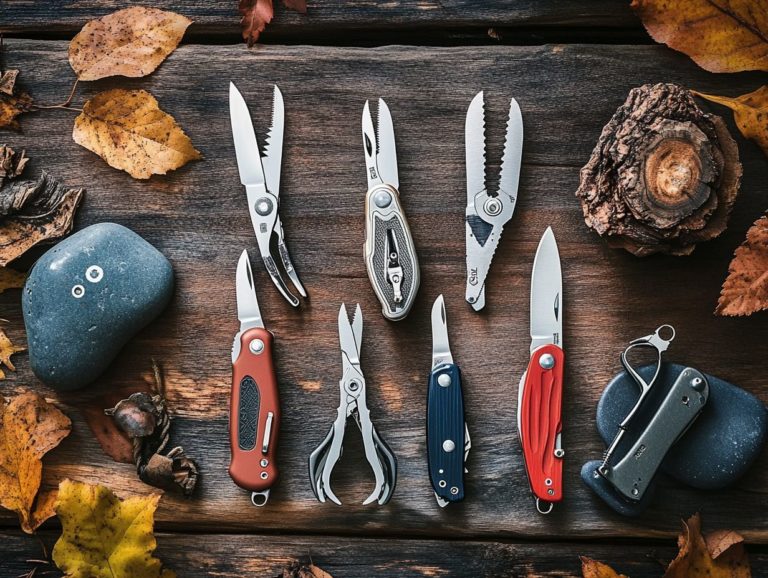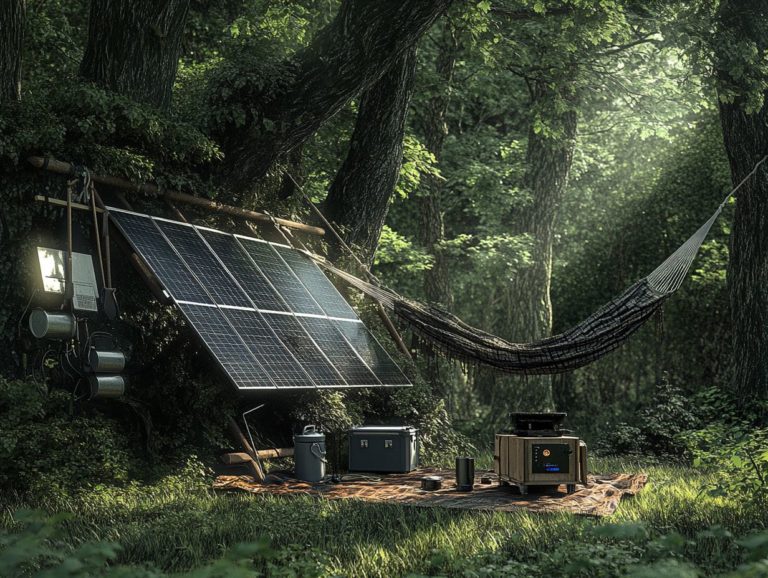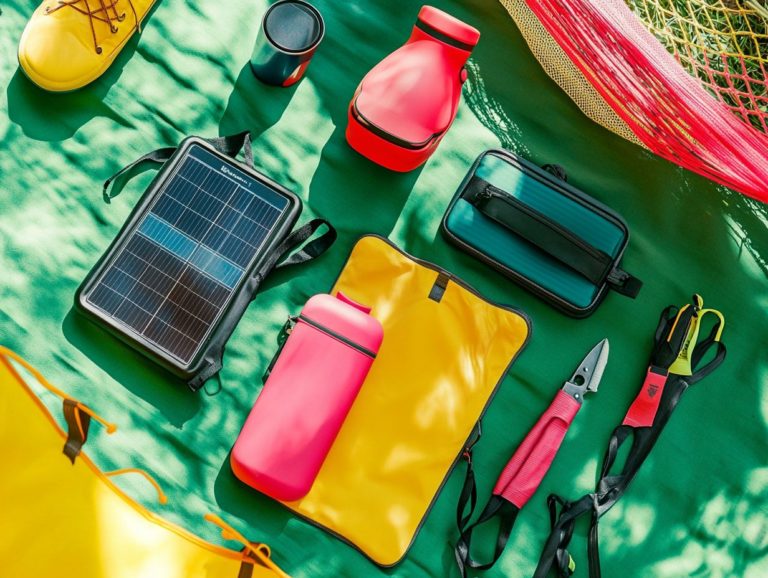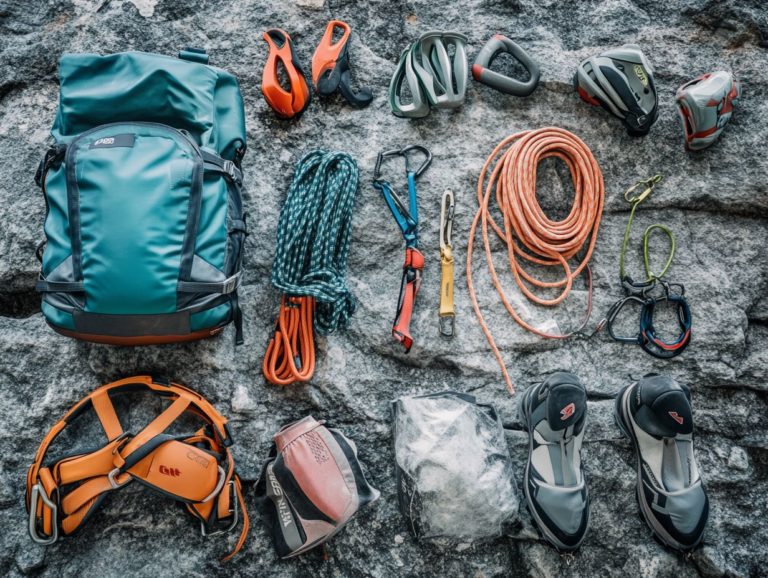Top 5 Accessories for Stargazing
Stargazing invites you into a universe brimming with wonder. The right accessories can transform your experience from ordinary to extraordinary.
Whether you re a seasoned astronomer or just beginning your journey, recognizing the tools that can enhance your evenings beneath the stars is essential.
Get ready to discover tips for choosing the perfect telescope, maximizing your experience, and the best locations to witness celestial magic.
Prepare to unlock the secrets of the night sky!
Contents
- Key Takeaways:
- 1. Telescope
- 2. Star Chart or Planisphere
- 3. Red Light Flashlight
- 4. Comfortable Seating
- 5. Smartphone or Tablet with Stargazing Apps
- How to Choose the Right Telescope for Stargazing?
- What Are the Different Types of Telescopes?
- What Are the Key Features to Consider When Buying a Telescope?
- How Can a Beginner Get Started with a Telescope?
- What Are the Best Stargazing Apps Available?
- How Can a Red Light Flashlight Enhance the Stargazing Experience?
- What Are the Benefits of Using a Star Chart or Planisphere?
- How Can Comfortable Seating Improve the Stargazing Experience?
- What Other Accessories Can Enhance the Stargazing Experience?
- How Can Stargazing Be Enjoyed Without Any Accessories?
- Top Stargazing Locations
- Frequently Asked Questions
- What are the top 5 must-have accessories for stargazing?
- Why is a telescope considered the most important accessory for stargazing?
- What is the purpose of a star chart or rotating star map when stargazing?
- Why is a red flashlight recommended for stargazing?
- How does a comfortable chair enhance the stargazing experience?
- Why is it important to have a blanket or warm clothing when stargazing?
Key Takeaways:
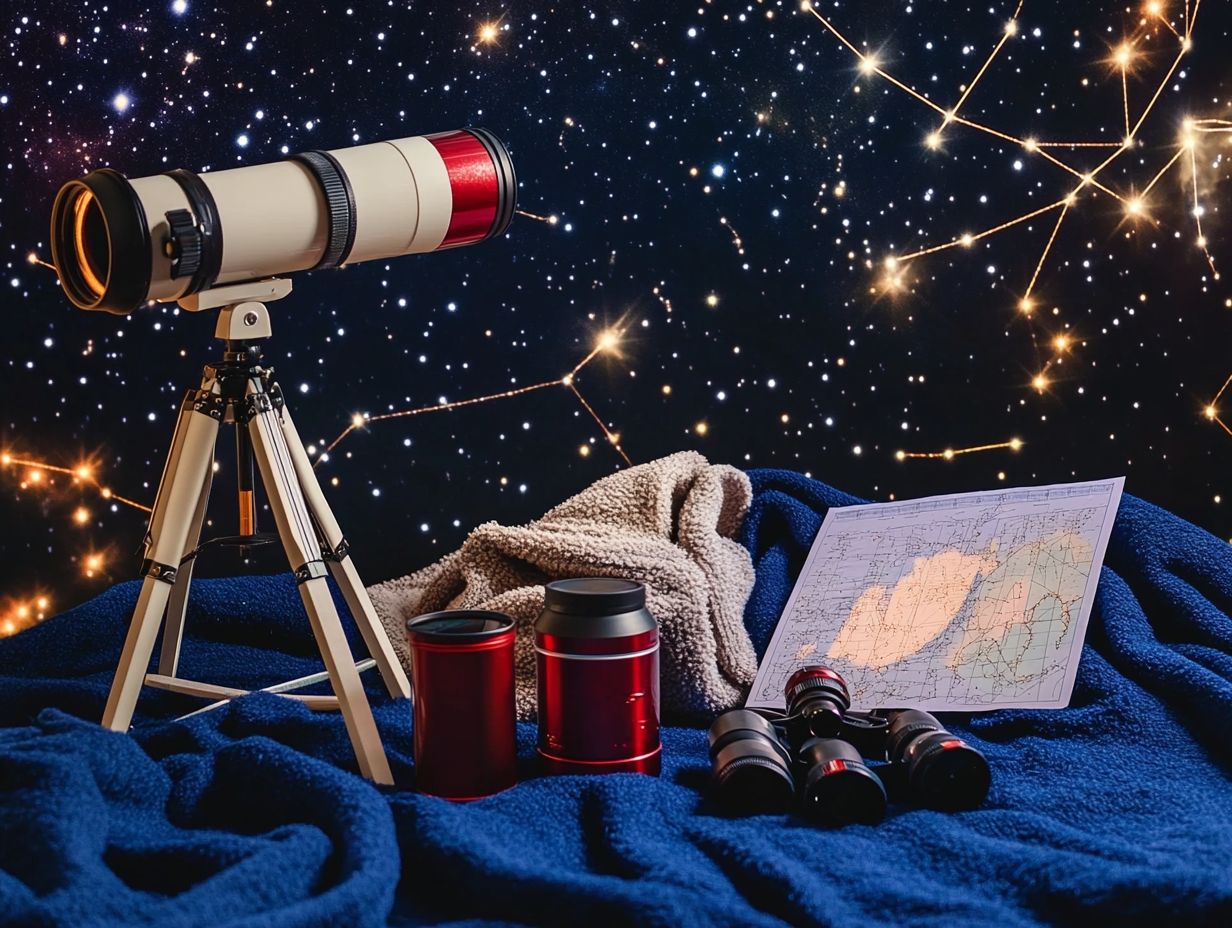
- A telescope is essential for stargazing. There are various types and features to consider when purchasing one.
- Stargazing apps on a smartphone or tablet can enhance your viewing experience. A red light flashlight helps preserve night vision.
- Comfortable seating and a star chart or planisphere greatly improve the stargazing experience. However, stargazing can still be enjoyed in the right location without any accessories.
1. Telescope
A telescope is an essential tool for you, whether you’re an aspiring astronomer or a casual stargazer. It helps you discover the night sky’s wonders and explore distant objects like planets, stars, and nebulae.
At Oceanside Photo & Telescope, you ll find an extensive selection of telescopes tailored to every level of expertise. Choose from refractors for planet viewing, reflectors for deep-sky photography, or compound models that offer versatility.
With our price match guarantee, you can be confident you re getting the best deal. Each model is designed to enhance your viewing experience, prioritizing portability, ease of use, or exceptional light-gathering capabilities.
By adding accessories, you can significantly improve image clarity and detail, turning a simple stargazing session into a stunning journey through the cosmos.
2. Star Chart or Planisphere
A star chart or planisphere is a must-have for every stargazer. It helps identify and locate various astronomical objects visible in the night sky with remarkable ease and accuracy.
These tools offer a clear map of stars and constellations, making them easy to find based on your geographic location and the current date. For those new to astronomy, they serve as an accessible guide, helping you build familiarity with celestial patterns.
Meanwhile, seasoned stargazers can employ them to efficiently locate specific stars, planets, and deep-sky treasures. When paired with telescopes, star charts elevate your stargazing experience, allowing you to pinpoint your desired targets with precision.
Ultimately, these charts foster a deeper connection with the cosmos, enriching your learning and enjoyment in the captivating field of astronomy.
3. Red Light Flashlight
A red light flashlight is crucial for you as a stargazer. It helps preserve your night vision while providing the illumination needed to navigate those dark evenings spent observing the cosmos.
The science behind this is fascinating. Bright white light can overwhelm your sensitive rods, making it challenging to see faint celestial objects. In contrast, red light has a longer wavelength that doesn t trigger the same response, allowing you to maintain your ability to see in low-light conditions.
To make the most of a red light flashlight while enjoying a night beneath the stars, aim the beam downwards or toward the ground. This minimizes direct exposure to your eyes, protecting your night vision and enhancing your overall stargazing experience.
With this approach, you can quickly readjust to the night sky and continue to marvel at those magnificent celestial displays without missing a beat.
4. Comfortable Seating
Comfortable seating is a crucial yet often overlooked element of a truly enjoyable stargazing experience. It allows you to remain relaxed and focused during those long, enchanting nights spent in pursuit of celestial wonders.
Regarding seating options, you have a range of choices that can elevate your experience. From reclining lounge chairs that offer ample support to portable camping stools that embrace a minimalist approach, each option has its own charm. Ergonomically designed chairs often come with adjustable features, enabling you to find that perfect position. This promotes better posture and reduces fatigue.
The right seating doesn t just make those extended observation sessions possible; it also enhances your visibility of the night sky by providing stability and a comfortable viewpoint. With adequate support, you can effortlessly shift your gaze across constellations, turning what could be a simple outing into an unforgettable journey among the stars.
5. Smartphone or Tablet with Stargazing Apps
In today’s digital age, your smartphone or tablet armed with stargazing apps has become an essential companion, whether you’re a budding astronomer or a seasoned sky gazer. These innovative applications provide real-time insights into constellations, planets, and other celestial wonders.
With the power of advanced technology at your fingertips, you can effortlessly interact with the night sky. By simply pointing your device toward the heavens, you can instantly identify stars and galaxies, delve into their fascinating histories, and even receive notifications about upcoming celestial events.
Many of these apps boast augmented reality features that elevate your stargazing experience, overlaying rich information on your live view of the sky. This seamless integration not only makes astronomy more accessible but also inspires a deeper connection with the universe, enabling you to uncover the wonders of the universe right from your backyard!
How to Choose the Right Telescope for Stargazing?
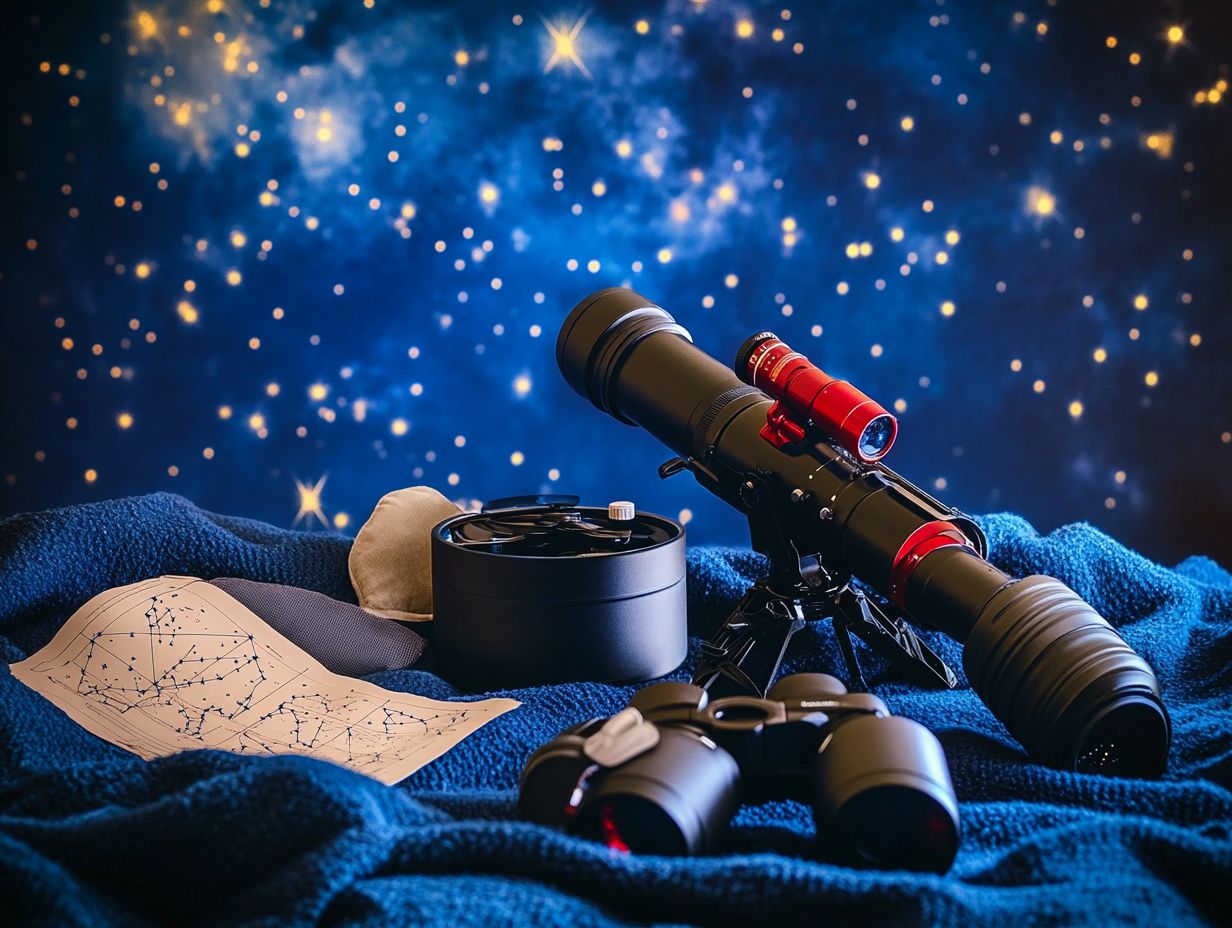
Choosing the right telescope for stargazing is an important choice that can significantly enhance your stargazing experience, allowing you to delve into the depths of space and witness breathtaking celestial events with remarkable clarity and precision.
It’s essential for you to evaluate crucial elements such as aperture size (the diameter of the telescope’s opening), which determines how much light your telescope can gather, and mount type, which impacts stability and ease of use. Considering your level of expertise whether you re a novice or a seasoned astronomer will help steer your selection.
Accessories like filters, eyepieces, and smartphone adapters can greatly enhance the versatility and effectiveness of your telescope.
To make the best choice, take the time to compare various models, read reviews, and check pricing across different retailers. This diligence will ensure you secure the best value for your investment, making your journey into the cosmos all the more rewarding.
What Are the Different Types of Telescopes?
Regarding stargazing, grasping the various types of telescopes available is essential. Each design refractor, reflector, and compound offers unique advantages tailored to your observing preferences and astronomical pursuits.
- Refractors use lenses to bend light, delivering crisp and high-contrast images. This makes them perfect for viewing planets and the moon in stunning detail.
- Reflectors, on the other hand, rely on mirrors and are ideal for deep-sky observation. Their larger apertures allow you to capture faint celestial objects that would otherwise remain hidden.
- Compound telescopes elegantly combine both lenses and mirrors. They excel in versatility, enabling you to switch effortlessly between planetary and deep-sky viewing depending on your mood.
If you’re venturing into astrophotography, it s crucial to consider factors like aperture and focal length, as they significantly impact image clarity and detail. Investing in stable mounting systems is essential for ensuring that celestial bodies remain steady during long exposures.
What Are the Key Features to Consider When Buying a Telescope?
Selecting the perfect telescope requires you to consider several key features that can significantly impact your observing experience. Important factors include the size of the opening that gathers light (aperture), the type of mount, and whether it has advanced technologies like an electronic focuser, which is a device that helps you focus your telescope automatically.
Aperture size is crucial for light gathering, enabling you to see clearer and brighter images of celestial objects. This is especially vital for deep-sky viewing. You will also need to decide on the mount type: alt-azimuth or equatorial options. Each has its own advantages based on your preferences. An equatorial mount makes it easier to track celestial movement, while an alt-azimuth mount prioritizes simplicity and ease of use.
Tracking systems enhance your observations by compensating for Earth’s rotation, ensuring your target remains in view. An electronic focuser can simplify adjustments, particularly for those passionate about astrophotography.
Ultimately, weighing these functionalities against your personal astronomical goals will help you prioritize the ideal telescope setup.
How Can a Beginner Get Started with a Telescope?
If you re embarking on an exciting journey into astronomy, starting with a telescope can be exhilarating. Keep a few essential stargazing tips in mind and become familiar with the basics of the night sky.
The first crucial step is selecting the right entry-level telescope. Consider factors like type, size, and ease of use to find the perfect fit for your needs. Explore popular options like refractors and reflectors. Make sure you understand key components such as magnification and aperture for the best viewing experience.
To familiarize yourself with the night sky, use apps and star charts that help you identify constellations and celestial objects. Engage with community resources like local astronomy clubs and online forums for invaluable support and insights. This will enhance both your knowledge and enjoyment of stargazing. Tapping into these resources significantly enriches your overall learning experience and cultivates a deeper appreciation for the cosmos.
What Are the Best Stargazing Apps Available?
The world of astronomy has been transformed by technology. You can elevate your stargazing experience with some of the finest apps available for smartphones and tablets. These tools provide insights into celestial events and objects, making your observations extraordinary.
Imagine having real-time sky mapping, augmented reality overlays, and notifications for upcoming astronomical events right at your fingertips. With these features, finding constellations, planets, and satellites becomes effortless. Users love the intuitive nature of these apps; simply point your device at the night sky to get instant information about what you’re seeing.
Many of these apps also offer community features, allowing you to connect with experienced stargazers and share tips. Added functionalities like personalized observation reminders and telescope integration enrich your stargazing journey, catering to both casual observers and devoted astronomers.
How Can a Red Light Flashlight Enhance the Stargazing Experience?
A red light flashlight is essential for improving your stargazing experience. It allows you to move around without jeopardizing your night vision, which is key for spotting elusive celestial gems.
It s amazing how your eyes adapt to darkness! Traditional white light can cause your pupils to constrict, reducing sensitivity to dim stars and planets. In contrast, red light has a longer wavelength, helping your eyes maintain their adaptation to darkness while still providing illumination. This balance lets you take notes, adjust your equipment, or navigate your surroundings with minimal interruption.
To maximize benefits, angle the flashlight downward or use a dimmer setting. By following these strategies, you ensure that your viewing experience remains immersive, allowing you to enjoy the wonders of the cosmos without distraction.
What Are the Benefits of Using a Star Chart or Planisphere?
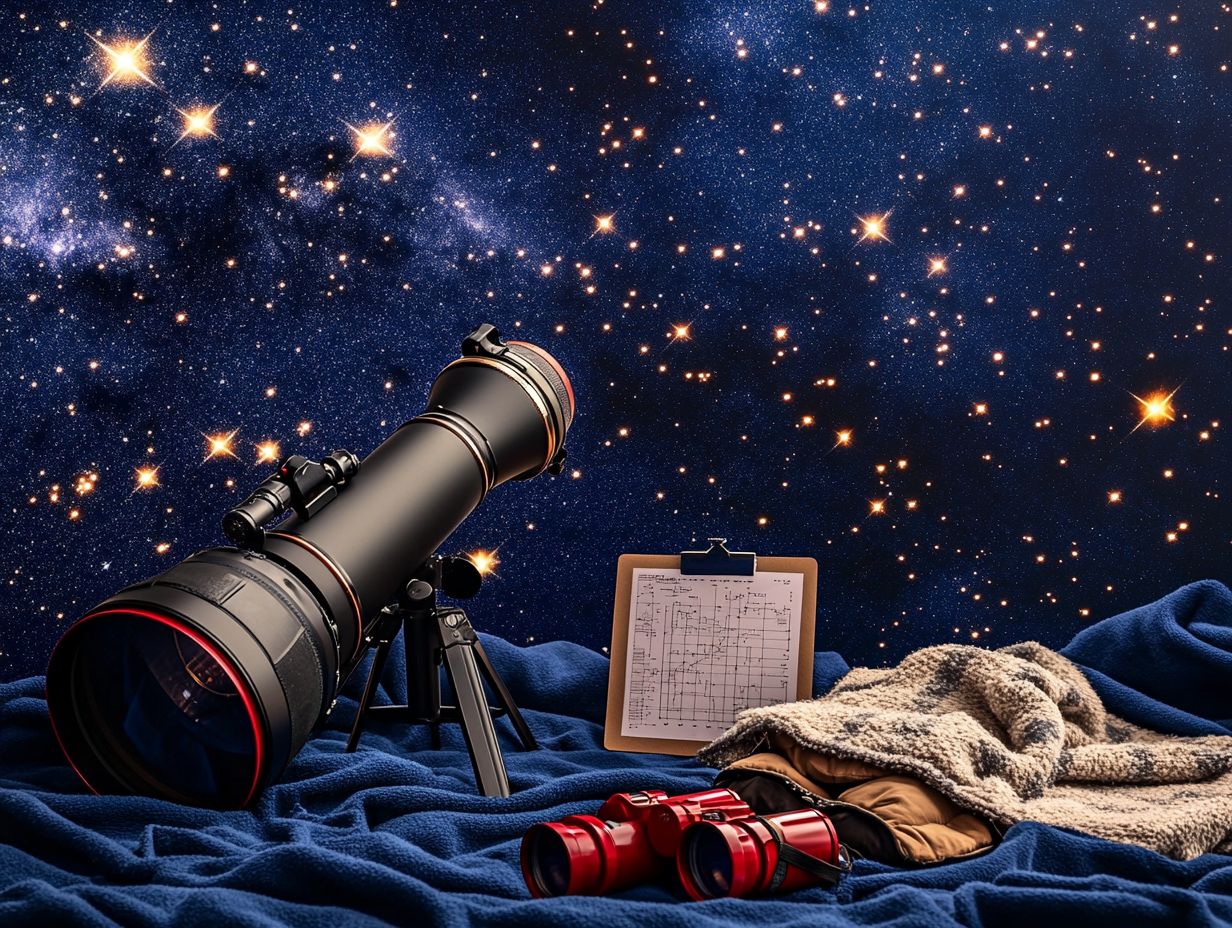
Utilizing a star chart or planisphere offers a wealth of benefits, including improved astronomical navigation and an enriched understanding of the cosmos.
These tools are essential for both novice and experienced stargazers alike. They act as your visual guides, beautifully displaying the arrangement of stars and constellations based on time and location. This makes it much easier to identify celestial bodies.
By aligning a planisphere with the current date and time, you can gain fascinating insights into how the night sky changes with the seasons.
Using star charts can deepen your knowledge, helping you appreciate astronomy as you learn to recognize patterns and significant celestial events.
To truly maximize their effectiveness, familiarize yourself with basic navigation techniques, like locating prominent stars or constellations. Additionally, consider the best viewing conditions, such as avoiding bright lights around you, to truly elevate your stargazing experience.
How Can Comfortable Seating Improve the Stargazing Experience?
Investing in comfortable seating can greatly enhance your stargazing experience, providing the support needed for those extended observation sessions.
Imagine reclining in a lounge chair with an adjustable backrest or settling into a portable camping stool that you can easily transport. The variety of seating options available ensures something that suits your preferences and environment.
Ergonomic designs enhance your posture and reduce fatigue, allowing you to stay engaged in your celestial explorations for longer periods.
Opting for cushioned seating made from weather-resistant fabric adds an extra layer of comfort, ensuring that the elements won t deter your enthusiasm for stargazing.
Choosing the right seat boosts your enjoyment and deepens your connection with the cosmos, transforming casual observations into unforgettable nights under the stars!
What Other Accessories Can Enhance the Stargazing Experience?
Besides your telescope, there s a wealth of accessories that can elevate your stargazing experience, including imaging filters, electronic focusers, and portable power supplies.
These tools enhance functionality and ease of use. They not only provide convenience but also enable you to capture stunning details of celestial images, ensuring that even faint objects become visible.
Imaging filters can significantly boost contrast, allowing you to admire nebulae and galaxies with striking clarity. Meanwhile, electronic focusers deliver razor-sharp views, providing precise adjustments that eliminate frustrations tied to manual focusing.
When paired with portable power supplies, which offer a dependable energy source for enchanting nights under the stars, you create an unforgettable and seamless observing experience. For anyone interested in astronomy, these accessories are definitely worth considering!
How Can Stargazing Be Enjoyed Without Any Accessories?
Stargazing can be an enriching experience, even without accessories. The sheer beauty of the night sky, adorned with constellations, planets, and other celestial wonders, possesses a unique charm that draws you in.
This approach allows you to connect deeply with the cosmos, embracing each twinkling star and drifting cloud as they reveal their stories. Engaging with celestial rhythms, like meteor showers or lunar eclipses, reminds you of your place in the vast universe.
With a cozy blanket and a clear night, you ll be amazed by the glow of the Milky Way, recognizing familiar shapes and patterns that echo ancient myths and modern science alike.
Appreciating these moments nurtures a sense of wonder and opens pathways to curiosity about distant galaxies and the mysteries they hold.
Top Stargazing Locations
Finding the best spots for stargazing is essential. Locations with minimal light pollution set the stage for an unforgettable cosmic display think stars, planets, and even nebulae.
National parks, often nestled far from urban chaos, offer expansive, open skies that are ideal for your night under the stars. If you want to elevate your experience even further, consider areas designated as dark sky reserves. These locations truly shine by protecting the night sky from artificial light, creating some of the clearest conditions for observation.
You might be surprised to learn that many enthusiasts find joy in stargazing right in their own backyards. With a bit of planning such as shielding your view from street lights you can unlock surprisingly magnificent views. Each of these locations enhances visibility and deepens your connection to the universe, making your stargazing experience captivating.
Frequently Asked Questions
What are the top 5 must-have accessories for stargazing?
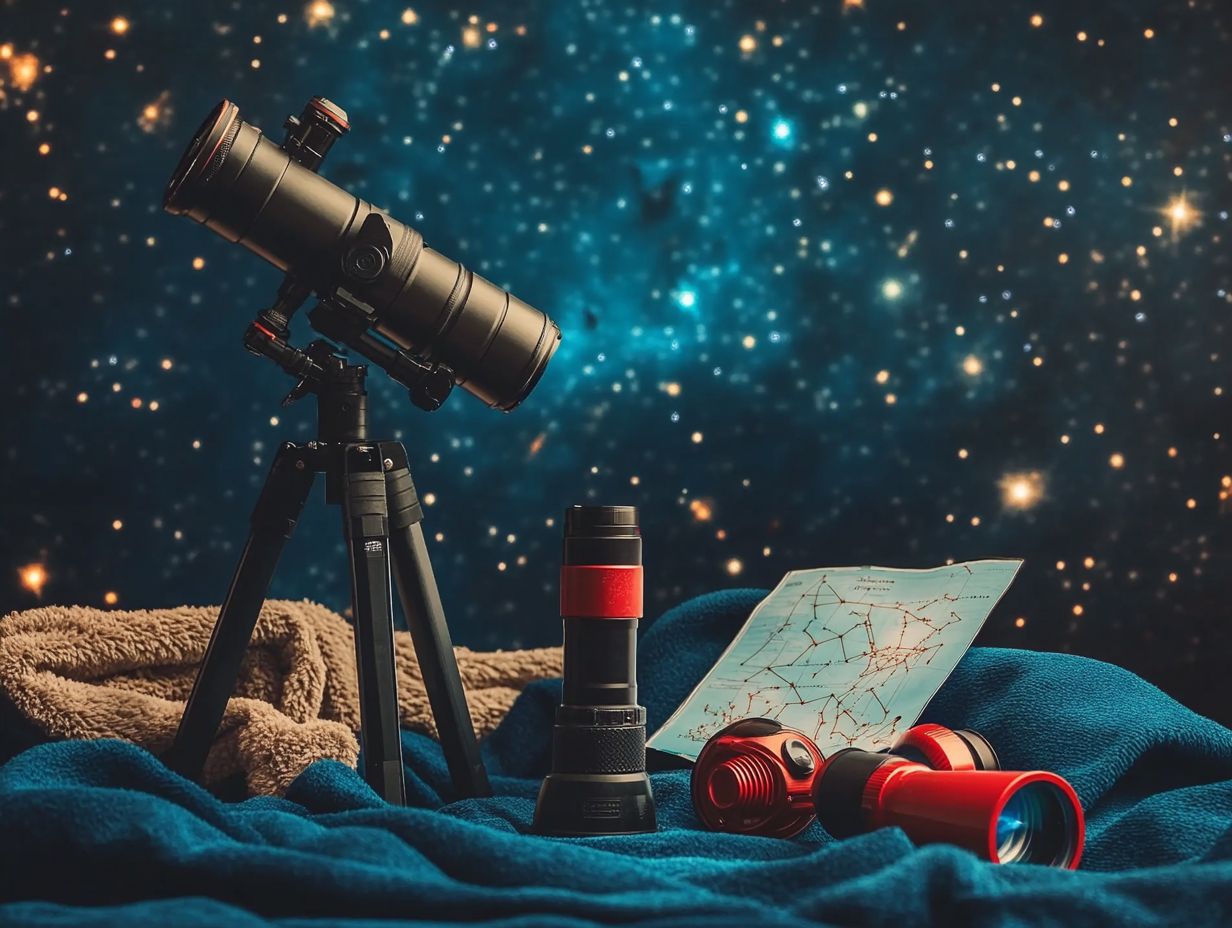
The top 5 accessories for stargazing include a telescope, a star chart or rotating star map, a red flashlight, a comfortable chair, and a blanket or warm clothing. A quality astrophotography rig can also significantly enhance your experience.
Why is a telescope considered the most important accessory for stargazing?
A telescope, such as those available from Oceanside Photo & Telescope, allows you to see distant celestial objects up close and in detail, making stargazing a much more immersive and rewarding experience.
What is the purpose of a star chart or rotating star map when stargazing?
A star chart or rotating star map helps you identify and locate specific stars, constellations, and other celestial objects, including fascinating nebulae, in the night sky. It also aids navigation and helps you understand the movement of stars and planets.
Why is a red flashlight recommended for stargazing?
Regular flashlights emit bright white light, which can disrupt your eyes’ natural adaptation to darkness and make it difficult to see stars. Red light, on the other hand, preserves your night vision and allows you to navigate without affecting your stargazing experience. This is especially important when using telescope accessories that require careful adjustment.
How does a comfortable chair enhance the stargazing experience?
Stargazing can involve long periods of standing or sitting. A comfortable chair allows you to relax and maintain a good viewing angle while using your imaging system, reducing strain on your neck and back.
Why is it important to have a blanket or warm clothing when stargazing?
Stargazing often takes place at night when temperatures can drop significantly. Having a blanket or warm clothing keeps you comfortable and allows you to stay outside longer to enjoy the night sky, especially while capturing images of astronomical objects.
Ready to explore the cosmos? Grab your accessories and head out for a stargazing night!

